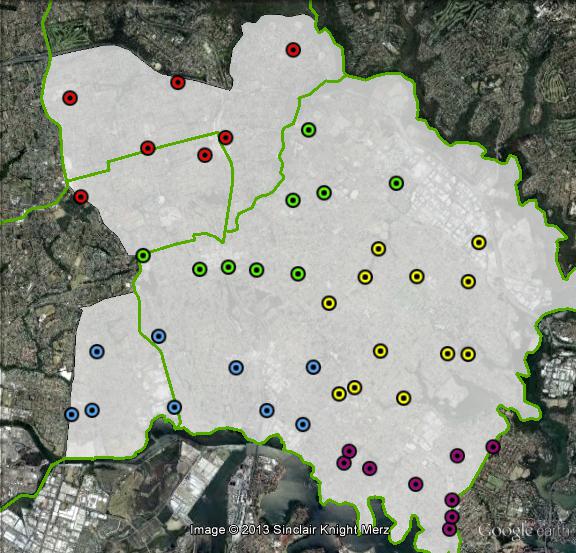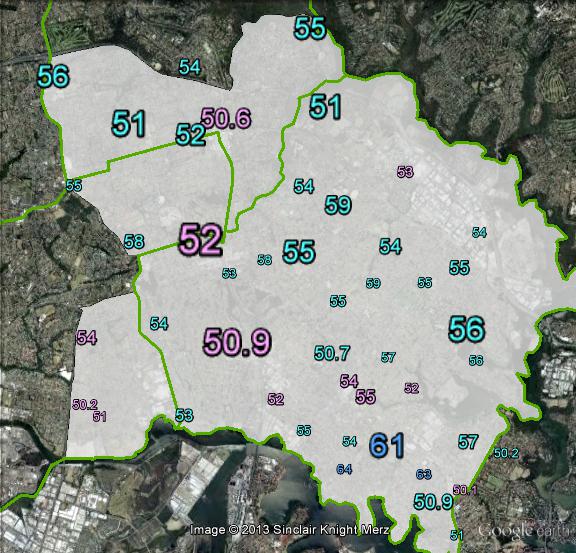LIB 3.1%
Incumbent MP
John Alexander, since 2010.
Geography
Bennelong straddles the north shore and western suburbs of Sydney. The seat covers the entirety of Ryde local government area, as well as Epping, Carlingford and Ermington, from Hornsby and Parramatta council areas. Main suburbs in the seat are Ryde, Epping, Ermington, Eastwood and Gladesville.
History
Bennelong was created in 1949, and was held by only two MPs between then and the 2007 federal election. Bennelong originally covered Ryde, Hunters Hill and Lane Cove, but not areas such as Eastwood and Epping that are now contained within the seat.
Bennelong was first won by John Cramer (LIB) in 1949. Cramer served as Minister for the Army under Robert Menzies from 1956 to 1963. During his time holding Bennelong the seat was never a very safe seat, and in 1961 Cramer only held on by 1832 votes. His largest margin was 15.4% in 1966.
Cramer retired at the 1974 election and was succeeded by John Howard (LIB). Howard went on to serve as a minister under Malcolm Fraser, including as Treasurer from 1977 to 1983. He then served in a variety of roles on the opposition frontbench after 1983, including as two stints as Opposition Leader (1985-1989, 1995-1996). He was elected as Prime Minister in 1996 and served until 2007.
The seat of Bennelong had gradually shifted to the north-west over the decades, taking in Epping. The 1992 redistribution saw the last parts of Lane Cove removed from the seat, and Howard’s margin was cut in 1993. After recovering in 1996 to a margin over 10% it gradually declined to a 4.3% margin in 2004, when the Greens ran high-profile former intelligence officer Andrew Wilkie against Howard.
The 2006 redistribution saw Howard’s margin cut slightly and the ALP decided to target the seat, running former journalist Maxine McKew. McKew won the seat with 51.4% of the two-party vote.
In 2010, McKew was defeated by former tennis champion John Alexander.
Candidates
- Lindsay Peters (Greens)
- Jason Yat-Sen Li (Labor)
- Julie Worsley (Christian Democratic Party)
- Rob Marks (Palmer United Party)
- Lachlan McCaffrey (Democratic Labour Party)
- John Alexander (Liberal)
- John August (Secular Party)
- Victor Waterson (Australia First)
Assessment
Bennelong is a marginal seat and certainly could change hands, but the seat has a long Liberal history and took a massive effort for Labor to win in 2007. The absence of McKew’s personal vote and Alexander’s new personal vote will also favour the Liberal Party.
2010 result
| Candidate | Party | Votes | % | Swing |
| John Alexander | LIB | 41,582 | 48.53 | +3.04 |
| Maxine McKew | ALP | 31,803 | 37.12 | -8.21 |
| Lindsay Peters | GRN | 6,808 | 7.95 | +2.42 |
| Julie Worsley | CDP | 1,824 | 2.13 | +0.84 |
| Sue Raye | SXP | 1,105 | 1.29 | +1.29 |
| Victor Waterson | ON | 725 | 0.85 | +0.55 |
| Stephen Chavura | FF | 570 | 0.67 | +0.34 |
| Mary Mockler | CA | 478 | 0.56 | +0.56 |
| Terje Petersen | LDP | 344 | 0.40 | +0.30 |
| Bill Pounder | CSC | 275 | 0.32 | +0.32 |
| Martin Levine | BA | 170 | 0.20 | +0.20 |
2010 two-candidate-preferred result
| Candidate | Party | Votes | % | Swing |
| John Alexander | LIB | 45,518 | 53.12 | +4.52 |
| Maxine McKew | ALP | 40,166 | 46.88 | -4.52 |

Booth breakdown
Booths have been divided into five parts around the main suburbs of Bennelong: Eastwood, Epping, Gladesville, Ryde and West Ryde.
The Liberal Party won a majority in all five areas, varying from 50.3% in West Ryde to 56.4% in Gladesville.
| Voter group | GRN % | LIB 2PP % | Total votes | % of votes |
| Eastwood | 8.01 | 53.01 | 16,150 | 18.85 |
| Ryde | 6.98 | 53.52 | 15,425 | 18.00 |
| Epping | 8.49 | 52.99 | 14,883 | 17.37 |
| West Ryde | 7.91 | 50.32 | 12,308 | 14.36 |
| Gladesville | 7.98 | 56.44 | 8,996 | 10.50 |
| Other votes | 8.27 | 53.26 | 17,922 | 20.92 |



RichR – there’s no proof of anything, but there’s evidence that might connect to it. Polls in 2010 underestimated the minor party votes until the very end, when it all balanced back out. The extent of the effect was smaller, though, which makes sense – at that point, the only minor party that got any real traction was the Greens… this time, there’s also the KAP and PUP.
Consider that the national polls were saying the KAP vote nationwide is 1%. Even if you assume that all of that is in Queensland, that still only brings the KAP vote up to about 5%. At the state election last year, KAP got 11.5% of the vote, and there’s no reason whatsoever to think that it will be lower at the federal level.
Think about it – can you think of a reasonable explanation for why swings of the order of 5-10% would happen within the last week? It’s not a “honeymoon period is over” situation, because that’s a gradual thing; people don’t collectively just spontaneously decide to change their mind all at once. A more feasible explanation is that people intending to vote Labor aren’t committed yet because Labor’s performance so far is weaker, while those intending to vote Liberal committed once Abbott had a reasonable performance (in their view, at least) during the debate.
Another example is the polling in Forde – multiple polls said Beattie would get a 5 point bump in the seat, and then the vote drops by 5 points? Is it more likely to be people spontaneously changing their mind en masse, or that the people who said they’d prefer Beattie are still waiting to see his campaigning while those who were leaning Liberal already decided it was the last nudge necessary to commit?
Combine all this with the fact that robopolls, which don’t provide “uncommitted” options, are showing the biggest swings, and it all makes sense. This doesn’t mean that the Coalition isn’t ahead, it just means that the polls aren’t to be trusted, just yet.
One of the most interesting polls is that Morgan Multi-Mode poll, which had Coalition ahead on 2PP by standard method, but when asked to choose their preference for themselves, respondents put Labor and Coalition at 50-50. This makes perfect sense if the preference choice is independent of the intended primary vote, and so people who were “uncommitted” in primary votes were more often choosing Labor in the 2PP.
So again – it’s a matter of which assumption is consistent with everything. And to me, “massive swing to Coalition over a single week” just isn’t consistent.
First of all, I don’t know where you are getting the proposition that there have been swings of 5 to 10 percentage points in a week. We don’t have polls for most of these seats from last week. Forde, of course, could be a honeymoon issue, for Beattie, not Rudd, and it disappeared quickly. Or it could be something else. The parachuting in of Beattie is a change that voters could come to be seen as calculated, cynical, or something along those lines. I’m also not sure what you mean by “multiple polls said Beattie would get a 5 point bump”. If you mean “that he had gotten a 5 point bump”, then that could be a honeymoon effect, as I said. If you mean that pollsters asked “what if Beattie became the candidate”, that sort of hypothetical is next to worthless.
I’m not sure I understand your logic about people inclined to vote Beattie waiting versus LNP supporters having made up their minds. The effect of the ReachTEL push is to force those who haven’t decided to pick, so your Beattie inclined voters would have said Beattie. And Lonergan takes response, then pushes. Doing so made little difference, and on balance it favoured the LNP,
As for KAP, there is no reason to think that it would have the same vote federally (in Queensland) as it did in the state election. The are different elections, with different issues, and voters engaging in a different process in deciding how to vote. Among the hundreds of differences is the fact that Labor was absolutely crushed 2012, and KAP took some of that vote. Since it is still with the ALP in this election, it obviously isn’t with KAP.
The difference between voter response and past preference flows is not something to rely on. This isn’t the first time those two have diverged, and the latter is the one that proves more reliable, at least in part because people tend to follow HTVs.
In the end, if there is actually a difference between the robopolls and the others, then you can take that as showing a lot of soft support, but imagining a world in which robopolls are behaving materially differently from the way they have before is just wishful thinking. It could be that the robopolls are putting out complete crap, in fact my gut says they are overstating the Coalition’s position, but the things you are pointing out just don’t seem to be strong reasons to believe it, any more than my gut is one.
RichR – I think it might be time to shift this discussion over to the “Day Eight” article, as this isn’t specifically about Bennelong. See my response there.
There will be Liberal supporters shifting from here into Parramatta to campaign from tomorrow.
There will be Liberal supporters shifting from here into western Sydney seats to campaign from tomorrow.
Which seats, out of interest (apart from Parramatta)?
Reid, Banks, Greenway.
PB seat of the day profile, http://blogs.crikey.com.au/pollbludger/2013/08/21/seat-of-the-day-bennelong/
Prediction: Liberal hold if the swings that are being sighted in Western Sydney are true. Even if they lose their viciousness, still can’t see Labor winning this despite nominating a good candidate.
Dear tallyroom,
John Alexander’s website leads to a 404 error. Also can anyone point me to information on the other candidates. Namely Worsley, Marks, August and Waterson, I am not particularly keen to vote for names in this election. I prefer to vote for people.
Regards,
Will